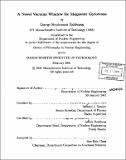A novel vacuum window for megawatt gyrotrons
Author(s)
Haldeman, George Stephenson, 1966-
DownloadFull printable version (19.20Mb)
Other Contributors
Massachusetts Institute of Technology. Dept. of Nuclear Engineering.
Advisor
Richard J. Temkin.
Terms of use
Metadata
Show full item recordAbstract
This thesis describes a new microwave output window for megawatt power level, 110 GHz gyrotrons. The window uses two spherically polished sapphire elements separated by a nearly uniform gap of about 1 mm. Pressurized, microwave transpar- ent coolant flows through this gap and across the transmitting aperture, removing absorbed energy at the element face. The design differs from previous face-cooled windows because the sapphire elements have a modestly curved dome, rather than flat shape. This curved shape increases the element's capability to withstand coolant pressures without significantly increasing stresses from differential heating. Conse- quently, window power can be increased either through enhanced, high pressure cool- ing or by using thinner elements with reduced microwave absorption. A model was developed to predict window power capability as a function of design geometry. This model predicted an increase from 0.5 to 2.1 MW when flat elements were changed to curved. Both designs used full size, 100 mm clear apertures, but the curved elements with 214 mm curvature radii were 1.3 rather than 1.75 mm thick. The model was also used to design a half size prototype experiment. This 50 mm clear aperture system used 60 mm OD x 0.47mm thick x 107mm surface radius elements. An initial piece was fabricated and statically tested to a pressure of 1.1 MPa well above the 0.5 MPa analytically predicted to be required for megawatt operation. The complete window structure was then fabricated, including instrumentation to simulate microwave heat- ing and to measure induced temperatures and strains. Test results demonstrated an equivalent continuous Gaussian beam power capability of 700 kW using a coolant flow of 1.1 lps. Scaling from this measurement, full size boiling limited power is expected to be 1.1 MW for a Gaussian microwave intensity profile, or 2.3 MW for a shaped profile typical of previous flat, face-cooled designs.
Description
Thesis (Ph.D.)--Massachusetts Institute of Technology, Dept. of Nuclear Engineering, 2001. Includes bibliographical references (leaves 215-220).
Date issued
2001Department
Massachusetts Institute of Technology. Department of Nuclear Engineering; Massachusetts Institute of Technology. Department of Nuclear Science and EngineeringPublisher
Massachusetts Institute of Technology
Keywords
Nuclear Engineering.